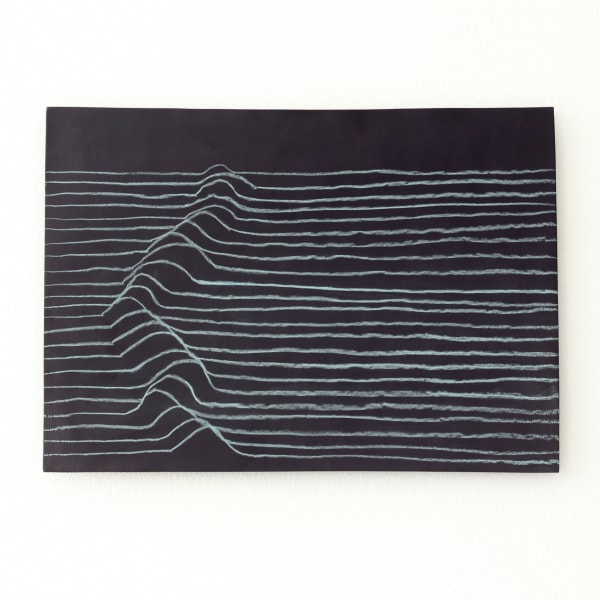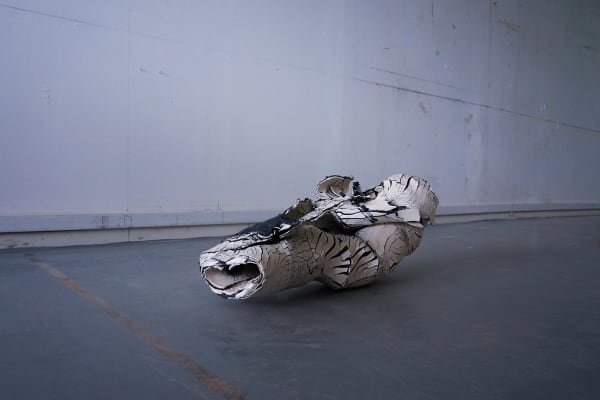Material Mimicry | Annie Johansson, Charlotta Bellander, Emma Nilsson, Paul-Robin Sjöström & Yanfeng Zhang
In "Material Mimicry" we present new works by five artists who, by using their own materials and idioms, in varying ways challenge what we experience, what we think we know and can. Breaking norms for what can be done, using materials in unknown ways, imitating and disguising.
In Emma Nilsson's floor sculptures, it is as if porcelain clay has been wrestling with galvanized steel mesh in a hot kiln, forever joined imitating distorted birch trunks. Her artistic process cannot be controlled and is completely handed over to the contrasting materials that in a way create themselves, finally give themselves up. The material's transformation with unpredictable cracking, random formations and movements becomes a testify to a struggle with a partially random ending.
Charlotta Bellander's series "Holding on to lines" awakens memories of the primary school's blackboards where someone spontaneously drawn lines with porous chalkboard chalk. But it is an illusion, her paintings are made in black porcelain with permanent lines impossible to erase. The inescapable remains after the paintings have been cut out in A3 format are important in her creative process, she builds new objects as an echo of the paintings. A composition of soft abstract objects of the remains becomes a contrast to the hard and austere.
Annie Johansson has in recent years been investigating wool as a material where she is interested in the physical processes of wet felting in relation to the maker, the doing and the object. Her work is highly sculptural, three-dimensional where corporeality is an important theme. Textile is an everyday material, close to us in all of our life; we may not have formulated ourselves about the material, but we still know the feeling of it. These tactile memories, this implicit bodily knowledge, constitute the entrance to and investigation of Annie's work: in a play with the material's sensuality and skin-likeness, she tries to reach a feeling in an attempt to communicate beyond words through the textile objects she creates.
Paul-Robin Sjöström’s formative language is precise, his technique masterful with full control. Yet, his playfulness vibrates in his sculptures in strong monochrome colors, matte finish with clear shapes and symbolism. The perfectly polished matt colourful ceramic surfaces and the wilful formative language challenge the viewer in reading the material. Can such a challanging material really be used to create works that are so "non-ceramic" and perfect?
Yanfeng Zhang lives and was educated in both China and Sweden, she has been assisting Mia E Göransson and most recently Kennet Williamsson. During the last six months she has investigated the creation of ceramic paintings or perhaps rather sublime reliefs. Using a Chinese noodle press, she has been making long strings of clay that are laid tightly, in a row. With a rolling pin, she then joins the strings where the relief or space in-between becomes a painting with references to Agnes Martin's minimalist paintings. It is a risky process, where few survive to fired and perfect works.
-
 Charlotta Bellander, Holding on to lines #1, 2019
Charlotta Bellander, Holding on to lines #1, 2019 -
 Charlotta Bellander, Holding on to lines #12, 2019
Charlotta Bellander, Holding on to lines #12, 2019 -
 Charlotta Bellander, Holding on to lines #4-5, 2019
Charlotta Bellander, Holding on to lines #4-5, 2019 -
 Emma Nilsson, Äntlig #1, 2018
Emma Nilsson, Äntlig #1, 2018 -
 Emma Nilsson, Håg, 2018
Emma Nilsson, Håg, 2018 -
 Yanfeng Zhang, Linger On #2, 2019
Yanfeng Zhang, Linger On #2, 2019 -
 Yanfeng Zhang, Linger On #4, 2019
Yanfeng Zhang, Linger On #4, 2019 -
 Paul-Robin Sjöström, Broken Promises, 2019
Paul-Robin Sjöström, Broken Promises, 2019 -
 Paul-Robin Sjöström, On fire, but not consumed, 2019
Paul-Robin Sjöström, On fire, but not consumed, 2019











